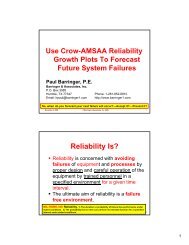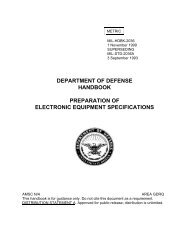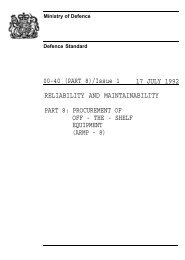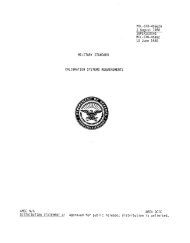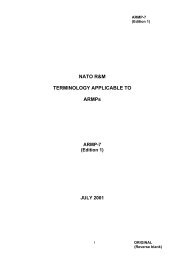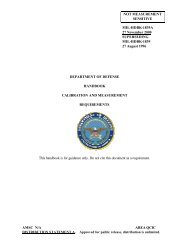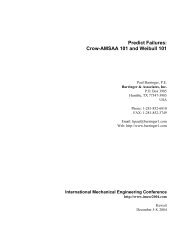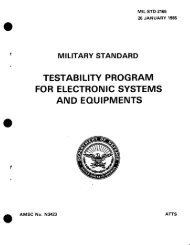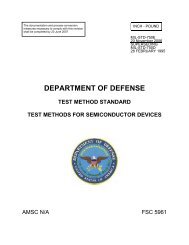MIL-STD-1629-RevA - Barringer and Associates, Inc.
MIL-STD-1629-RevA - Barringer and Associates, Inc.
MIL-STD-1629-RevA - Barringer and Associates, Inc.
You also want an ePaper? Increase the reach of your titles
YUMPU automatically turns print PDFs into web optimized ePapers that Google loves.
<strong>MIL</strong>-S’I’D-<strong>1629</strong>Aconditions can be ue~eloped shall be presented. A definition of theoperational <strong>and</strong> environmental stresses the system is expected to undergo,as well as failure definitions, will either be provided or must bedeveloped.4.4.1.2 Trade-off study reports, These reports should identifyareas of marginal <strong>and</strong> state-of-the-drt design <strong>and</strong> explain any designcompromises <strong>and</strong> operating restraints agreed upon. This information willaid in determining the possible <strong>and</strong> most probable failure modes <strong>and</strong>causes in the system..4.4.1.3 Design data <strong>and</strong> drawings. Design data <strong>and</strong> drawingsidentify each item <strong>and</strong> the item configuration that perform each of thesystem functions. System design data <strong>and</strong> drawings will usually describethe system’s internal <strong>and</strong> interface functions beginning at system level<strong>and</strong> progressing to the lowest indenture level of the system. Designdata will usually include either functional block diagrams or schematicsthat will facilitate construction of reliability block diagrams.4.4.1.4 Reliability data. The determination of the possible <strong>and</strong>probable failure modes requires an analysis of reliability data on theitem selected to perform each of the system internal functions. It iSalways desirable to usc reliability data resulting from reliabilitytests run on the specific equipment to be used with the tests perfornedunder the identical conditions of use. When such test data are notavailable, reliability data from <strong>MIL</strong>-liDBK-217 or from operatio[~al experience<strong>and</strong> tests performed under similar use conditions on items similar tothose in the systems should be used.4.4.2 FMEA process. The FMEA shall be initiated as an integralpart of early design process of system functional assemblies <strong>and</strong> shallbe updated to reflect design changes. Current FMEA analysis shall be amajor consideration at each design review from preliminary through thefinal design. The analysis shall be used to assess high risk items <strong>and</strong>the activities underway to provide corrective actions. The FMEA sl]allalso be used to define special test considerations, quality inspectionpoints, preventive maintenance actions, operational constraints, usefullife, <strong>and</strong> other pertinent information <strong>and</strong> activities necessary to minimizefailure risk. All recommended actions which result from the FMEA shallbe evaluated <strong>and</strong> formally dispositioned by appropriate implementation ordocumented rationale for no action. Unless otherwise specified, thefollowing discrete steps shall be used in performing an FMEA:a. Define the system tc be analyzed. Complete systemdefinition includes identification of internal <strong>and</strong>interface functions, expected performance at allindenture levels, system restraints, <strong>and</strong> failuredefinitions. Functional narratives of the systemshould include descriptions of each mission in termsof funccions which identif~’ tasks to be perfc~rmed—



